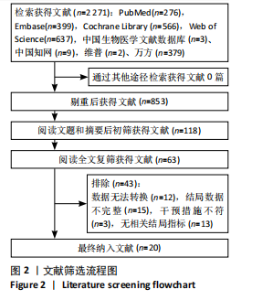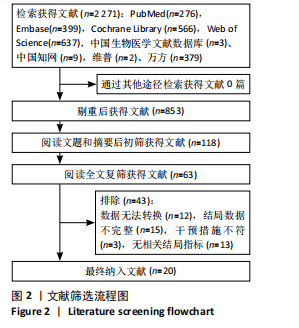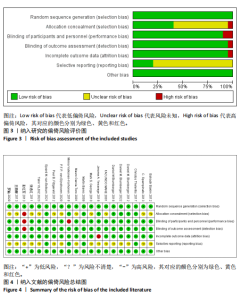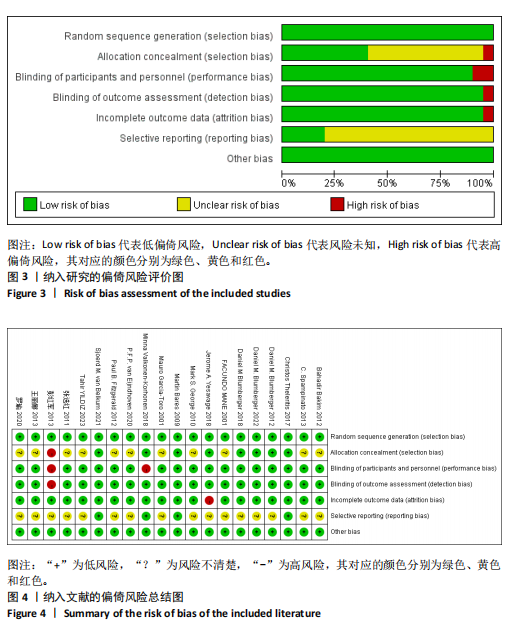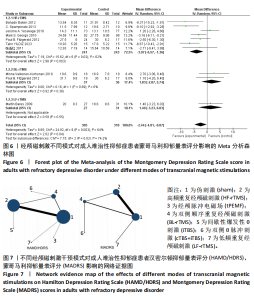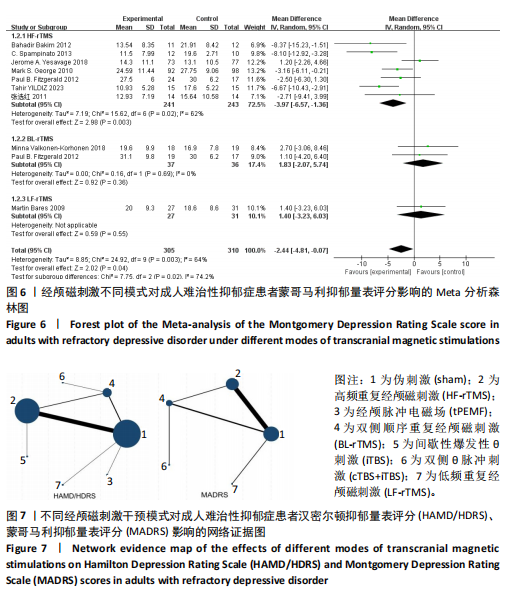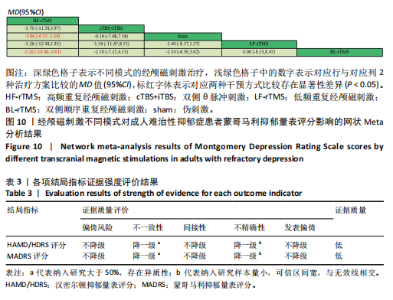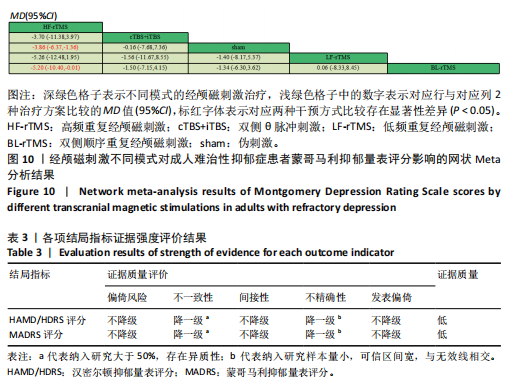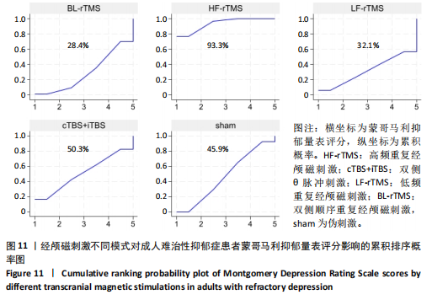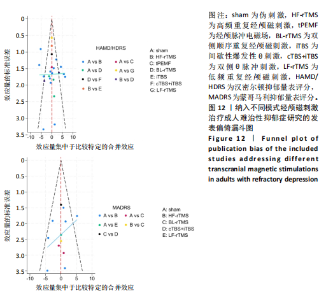Chinese Journal of Tissue Engineering Research ›› 2025, Vol. 29 ›› Issue (35): 7639-7648.doi: 10.12307/2025.966
Previous Articles Next Articles
Effects of different transcranial magnetic stimulation modes on refractory depression in adults: a network meta-analysis
Tian Jinxin, Zhao Yuxin, Hu Tong, Cui Tiantian, Ma Lihong
- College of Rehabilitation Medicine, Shandong University of Traditional Chinese Medicine, Jinan 250355, Shandong Province, China
-
Received:2024-11-07Accepted:2024-12-25Online:2025-12-18Published:2025-05-07 -
Contact:Ma Lihong, Master, Professor, College of Rehabilitation Medicine, Shandong University of Traditional Chinese Medicine, Jinan 250355, Shandong Province, China -
About author:Tian Jinxin, Master candidate, College of Rehabilitation Medicine, Shandong University of Traditional Chinese Medicine, Jinan 250355, Shandong Province, China -
Supported by:Research Planning Project of Shandong Higher Medical Education Research Center, No. YJKT202112 (to MLH)
CLC Number:
Cite this article
Tian Jinxin, Zhao Yuxin, Hu Tong, Cui Tiantian, Ma Lihong. Effects of different transcranial magnetic stimulation modes on refractory depression in adults: a network meta-analysis[J]. Chinese Journal of Tissue Engineering Research, 2025, 29(35): 7639-7648.
share this article
Add to citation manager EndNote|Reference Manager|ProCite|BibTeX|RefWorks
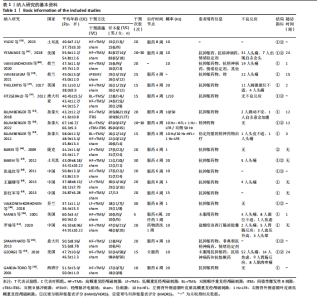
2.2 纳入文献基本特征 文章共纳入20篇文献,1 679例难治性抑郁症患者,发表年限为 2001-2023 年,包含高频重复经颅磁刺激(HF-rTMS)、低频重复经颅磁刺激(LF-rTMS)、双侧顺序重复经颅磁刺激(BL-rTMS)、间歇性爆发性θ刺激(intermittent theta burst stimulation,iTBS)、双侧θ脉冲刺激(iTBS+ cTBS)、经颅脉冲电磁场(transcranial pulsed electromagnetic field,tPEMF),共6种TMS方案。纳入文献的基本特征见表1。 2.3 纳入文献的质量评价结果 纳入的20项研究均为随机分组[13-32],其中7项研究标明进行分配隐藏(低风险)[18,20-21,27-29,31];18项研究对研究对象施盲(低风险)[13-19,22-32],19项研究对评估者施盲(低风险)[13,15-32];所有研究结果数据完整(低风险)[13-32]。研究评估结果见图3,4。 文献质量评价结果显示15 项研究为高质量[13-17,19-26,30,32],5 项研究为极高质量[18,27-29,31],平均8.3分,纳入文献总体质量较高,见表2。 2.4 传统Meta分析结果 在汉密尔顿抑郁量表评分方面,包含19篇文献[13-17,19-32],共有4种TMS模式。整体异质性检验,I2=83%,P < 0.05,提示各研究间差异较大。根据TMS模式的不同进行亚组分析,结果显示异质性仍然较高,因此仅对结果做描述性分析。与伪刺激相比,HF-rTMS、LF-rTMS均能显著改善患者抑郁症状,见图5。 在蒙哥马利抑郁量表评分方面,包含10篇文献[16-18,20,22,24,26,28,31-32],"
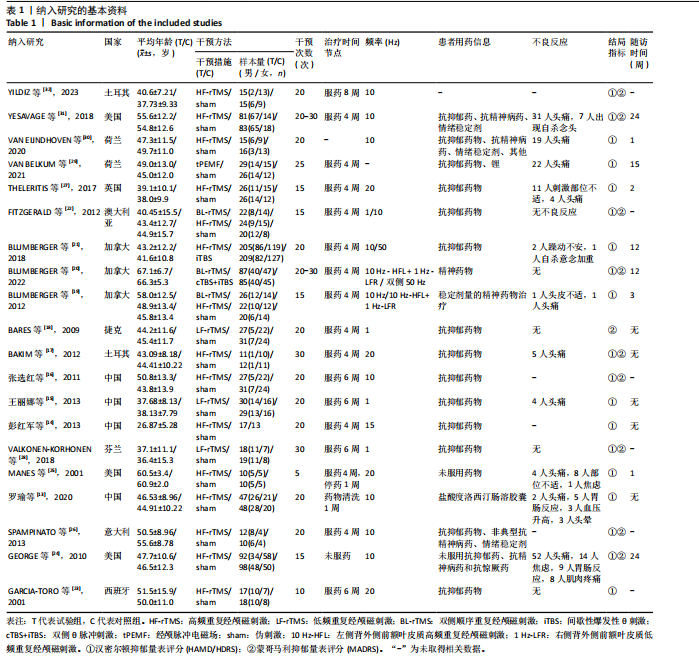
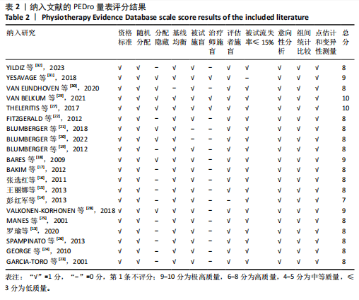
共有3种TMS模式。整体异质性检验,I2=64%,P < 0.05,提示各研究间差异较大,根据TMS模式的不同进行亚组分析,结果显示异质性仍然较高,因此仅对结果做描述性分析。与伪刺激相比,HF-rTMS能显著改善患者抑郁症状,见图6。 2.5 网状Meta 分析结果 2.5.1 网络证据图分析结果 (1)汉密尔顿抑郁量表评分纳入研究证据关系:共19篇文献涉及 汉密尔顿抑郁量表评分[13-17,19-32],在对汉密尔顿抑郁量表评分的网状Meta分析中,整体不一致性检验,结果显示P=0.358 1,节点分裂法对局部进行不一致性检验,结果显示各组比较均为P > 0.05[33],故使用一致性模型进行分析。网状Meta分析共涉及到HF-rTMS、 tPEMF、BL-rTMS、iTBS、cTBS+iTBS、LF-rTMS 6种TMS模式,其中 HF-rTMS、tPEMF、BL-rTMS、LF-rTMS刺激模式均与伪刺激进行直接比较,BL-rTMS与cTBS+iTBS、HF-rTMS与iTBS、HF-rTMS与BL-rTMS之间进行直接比较[34],图中圆点大小表示样本量大小,圆点之间的连线代表2种干预方式之间存在直接比较,连线越粗表示研究比较数量越多,若2种干预方式之间不存在直接比较则没有连线,可通过间接连线进行比较。对于对汉密尔顿抑郁量表评分,不同TMS模式的网状关系见图7。 (2)蒙哥马利抑郁量表评分纳入研究证据关系:共10篇文献涉及蒙哥马利抑郁量表评分[16-18,20,22,24,26,28,31-32],在对蒙哥马利抑郁量表评分的网状Meta分析中,整体不一致性检验,结果显示P=0.825,节点分裂法对局部"

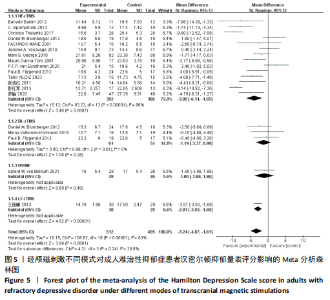
进行不一致性检验,结果显示各组比较均为P > 0.05[33],故使用一致性模型进行分析。网状Meta 分析共涉及到HF-rTMS、BL-rTMS、cTBS+iTBS、LF-rTMS 4种TMS模式,其中HF-rTMS、BL-rTMS、LF-rTMS刺激模式均与伪刺激进行直接比较,BL-rTMS与cTBS+iTBS、HF-rTMS与BL-rTMS之间进行直接比较[34]。对于蒙哥马利抑郁量表评分,不同TMS模式的网状关系见图7。 2.5.2 纳入研究的累积概率排序比较 在汉密尔顿抑郁量表评分结局指标方面,包括19篇文献[13-17,19-32],共1 621例患者,涉及6种TMS模式。与伪刺激组相比,HF-rTMS组降低难治性抑郁症患者汉密尔顿抑郁量表评分的效果更优,差异有显著性意义(MD=-3.84,95%CI:-5.86至-1.81),见图8。根据估计概率值与效应量大小对不同干预方式的改善效果进行排序,结果显示HF-rTMS(69.9%) > iTBS(62.8%) > cTBS+iTBS(57.5%) > LF-rTMS(54.9%) > BL-rTMS(49.0%) > tPEMF(37.0%) > 伪刺激(18.9%),累计概率比较见图9。 在蒙哥马利抑郁量表评分结局指标方面,包括10篇文献[16-18,20,22,24,26,28,31-32],共820例患者,涉及4种TMS模式,结果显示HF-rTMS组与伪刺激组、HF-rTMS组与BL-rTMS组比较差异有显著性意义(MD=-3.86,95%CI:-6.37至-1.36),见图10。根据估计概率值与效应量大小对不同干预方式的改善效果进行排序,结果显示HF-rTMS(93.3%) > cTBS+ iTBS (50.3%) >伪刺激(45.9%) > LF-rTMS (32.1%) > BL-rTMS (28.4%),累计概率比较见图11。 2.6 发表偏倚分析 纳入研究的发表偏倚漏斗图,见图12。针对汉密尔顿抑郁量表评分的漏斗图,大部分圆点整体分布均匀且位于漏斗图内部,说明有较小的可能性存在发表偏倚,但有少量圆点分布在漏斗图外侧,提示纳入研究有小样本效应的可能性。针对蒙哥马利抑郁量表评分的漏斗图,纳入研究的圆点在漏斗图分布大致对称,说明存在发表偏倚的可能性较小。 2.7 不良反应分析 纳入的20篇文献中,有11篇文献提及不良反应事"
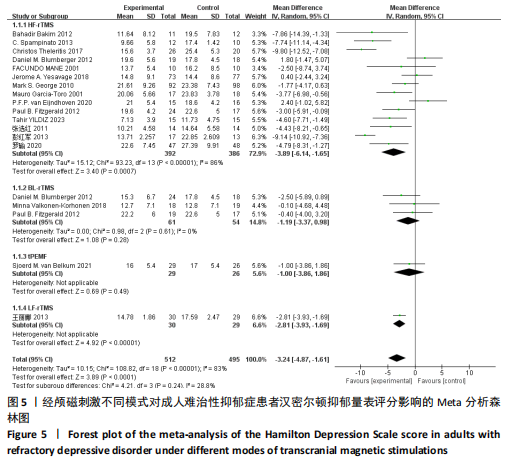
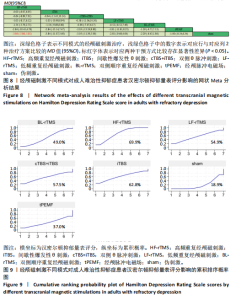
件[13,15,17,19,21,24-25,27,29-31],包括头痛、刺激部位不适、出现自杀念头、抑郁症状加重、肌肉疼痛、胃肠反应及食欲不振等,大多数出现不良反应的患者经过处理或休息后能自行缓解,仅有1 篇文献报道患者出现严重不良反应事件[21]。 2.8 GRADE证据分级结果 该研究纳入文献质量较高,均为A级,风险偏倚较小,纳入研究均设置为患者及评估者双盲,部分研究包含操作者设盲。然而针对不同结局指标的纳入研究异质性较大,且总体可信区间较宽,与无效线相交,从而降低该研究的证据质量。GRADE证据分级中2项结局指标为低级,经敏感性分析后异质性仍存在,可能会对结论的可靠性产生影响,见表3。 通过分析结果可得HF-rTMS在缓解难治性抑郁症效果最佳,其次是iTBS。对不良反应分析可得TMS 疗法产生的轻度不良反应大多可通过简单处理和休息即能自行缓解,与其他有创性治疗方法相比总体安全性较好。"
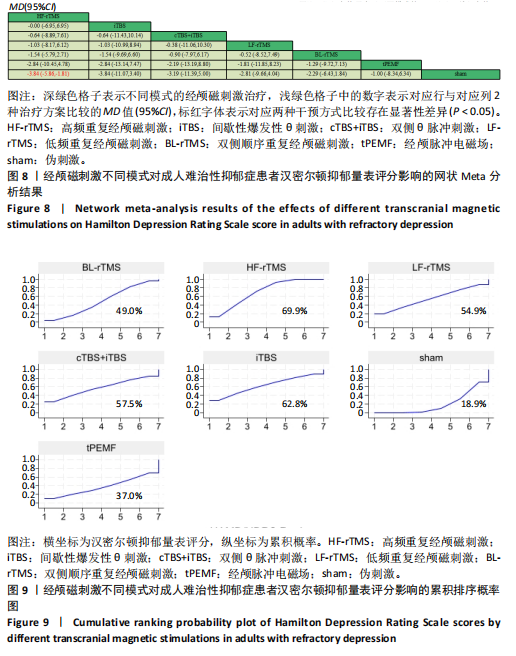
| [1] HERRMAN H, PATEL V, KIELING C, et al. Time for united action on depression: a Lancet-World Psychiatric Association Commission. Lancet. 2022; 399(10328):957-1022. [2] PULL CB. DSM-IV. Encephale. 1995;21:15-20. [3] BATTLE DE. Diagnostic and Statistical Manual of Mental Disorders (DSM). Codas. 2013;25(2):191-192. [4] OTTE C, GOLD SM, PENNINX BW, et al. Major depressive disorder. Nat Rev Dis Primers. 2016;2: 16065. [5] GAYNES BN, LUX L, GARTLEHNER G, et al. Defining treatment-resistant depression. Depress Anxiety. 2020;37(2):134-145. [6] KVERNO KS, MANGANO E. Treatment-Resistant Depression: Approaches to Treatment. J Psychosoc Nurs Ment Health Serv. 2021;59(9):7-11. [7] HAVLIK JL, WAHID S, TEOPIZ KM, et al. Recent Advances in the Treatment of Treatment-Resistant Depression: A Narrative Review of Literature Published from 2018 to 2023. Curr Psychiatry Rep. 2024;26(4):176-213. [8] LEFAUCHEUR JP. Transcranial magnetic stimulation. Handb Clin Neurol. 2019;160:559-580. [9] O’REARDON JP, SOLVASON HB, JANICAK PG, et al. Efficacy and safety of transcranial magnetic stimulation in the acute treatment of major depression: a multisite randomized controlled trial. Biol Psychiatry. 2007;62(11):1208-1216. [10] PERERA T, GEORGE MS, GRAMMER G, et al. The Clinical TMS Society Consensus Review and Treatment Recommendations for TMS Therapy for Major Depressive Disorder. Brain Stimul. 2016; 9(3):336-346. [11] 杨钰琳,常万鹏,丁江涛,等.经颅直流电刺激不同靶点治疗帕金森病效果的网状Meta分析[J].中国组织工程研究,2024,28(11):1797-1804. [12] 崔甜甜,杨钰琳,崔腾腾,等.不同强化训练对脑性瘫痪儿童上肢运动功能效果的网状Meta分析[J].中国康复理论与实践,2024,30(4):437-448. [13] 罗瑜,谷悦,刘海生,等.洛西汀联合高频重复经颅磁刺激治疗难治性抑郁症的对照研究[J].临床精神医学杂志,2020,30(1):60-62. [14] 彭红军,李凌江,郑会蓉.反复经颅磁刺激治疗对难治性抑郁症白质微结构整合水平的影响[J].中国临床心理学杂志,2013,21(4):528-531. [15] 王丽娜,潘飞,李玉凤.低频重复经颅磁刺激对难治性抑郁症的疗效及认知功能的影响[J].中国康复医学杂志,2013,28(6):544-548. [16] 张选红,王立伟,王继军,等.经颅磁刺激治疗难治性抑郁症的双盲随机对照研究[J].上海精神医学,2011,23(1):17-24. [17] BAKIM B, UZUN UE, KARAMUSTAFALIOGLU O, et al. The combination of antidepressant drug therapy and high-frequency repetitive transcranial magnetic stimulation in medication-resistant depression. Klinik Psikofarmakol Bulteni. 2012; 22(3):244-253. [18] BARES M, KOPECEK M, NOVAK T, et al. Low frequency (1-Hz), right prefrontal repetitive transcranial magnetic stimulation (rTMS) compared with venlafaxine ER in the treatment of resistant depression: a double-blind, single-centre, randomized study. J Affect Disord. 2009;118(1-3): 94-100. [19] BLUMBERGER DM, MULSANT BH, FITZGERALD PB, et al. A randomized double-blind sham-controlled comparison of unilateral and bilateral repetitive transcranial magnetic stimulation for treatment-resistant major depression. World J Biol Psychiatry. 2012;13(6):423-435.
[20] BLUMBERGER DM, MULSANT BH, THORPE KE, et al. Effectiveness of Standard Sequential Bilateral Repetitive Transcranial Magnetic Stimulation vs Bilateral Theta Burst Stimulation in Older Adults With Depression: The FOUR-D Randomized Noninferiority Clinical Trial. JAMA Psychiatry. 2022;79(11):1065-1073. [21] BLUMBERGER DM, VILA-RODRIGUEZ F, THORPE KE, et al. Effectiveness of theta burst versus high-frequency repetitive transcranial magnetic stimulation in patients with depression (THREE-D): a randomised non-inferiority trial. Lancet. 2018; 391(10131):1683-1692. [22] FITZGERALD PB, HOY KE, HERRING SE, et al. A double blind randomized trial of unilateral left and bilateral prefrontal cortex transcranial magnetic stimulation in treatment resistant major depression. J Affect Disord. 2012;139(2):193-198. [23] GARCIA-TORO M, MAYOL A, ARNILLAS H, et al. Modest adjunctive benefit with transcranial magnetic stimulation in medication-resistant depression. J Affect Disord. 2001;64(2-3):271-275. [24] GEORGE MS, LISANBY SH, AVERY D, et al. Daily left prefrontal transcranial magnetic stimulation therapy for major depressive disorder: a sham-controlled randomized trial. Arch Gen Psychiatry. 2010;67(5):507-516. [25] MANES F, JORGE R, MORCUENDE M, et al. A controlled study of repetitive transcranial magnetic stimulation as a treatment of depression in the elderly. Int Psychogeriatr. 2001;13(2):225-231. [26] SPAMPINATO C, AGUGLIA E, CONCERTO C, et al. Transcranial magnetic stimulation in the assessment of motor cortex excitability and treatment of drug-resistant major depression. IEEE Trans Neural Syst Rehabil Eng. 2013;21(3):391-403. [27] THELERITIS C, SAKKAS P, PAPARRIGOPOULOS T, et al. Two Versus One High-Frequency Repetitive Transcranial Magnetic Stimulation Session per Day for Treatment-Resistant Depression: A Randomized Sham-Controlled Trial. J ECT. 2017;33(3):190-197. [28] VALKONEN-KORHONEN M, LEINOLA H, KÖNÖNEN M, et al. Bifrontal active and sham rTMS in treatment-resistant unipolar major depression. Nord J Psychiatry. 2018;72(8):586-592. [29] VAN BELKUM SM, DE BOER MK, OPMEER EM, et al. No antidepressant effects of low intensity transcranial pulsed electromagnetic fields for treatment resistant depression. J Affect Disord. 2021;294:679-685. [30] VAN EIJNDHOVEN PFP, BARTHOLOMEUS J, MÖBIUS M, et al. A randomized controlled trial of a standard 4-week protocol of repetitive transcranial magnetic stimulation in severe treatment resistant depression. J Affect Disord. 2020;274:444-449. [31] YESAVAGE JA, FAIRCHILD JK, MI Z, et al. Effect of Repetitive Transcranial Magnetic Stimulation on Treatment-Resistant Major Depression in US Veterans: A Randomized Clinical Trial. JAMA Psychiatry. 2018;75(9):884-893. [32] YILDIZ T, OĞUZHANOĞLU NK, TOPAK OZ. Cognitive outcomes of transcranial magnetic stimulation in treatment-resistant depression: a randomized controlled study. Turk J Med Sci. 2023;53(1):253-263. [33] 胡通,李萱,袁静,等.不同电磁刺激方案改善脑卒中后吞咽障碍的网状 Meta 分析[J].中国组织工程研究,2025,29(24):5224-5236. [34] 熊丹,谢海花,李浩,等.不同重复经颅磁刺激模式对脑卒中后上肢运动功能障碍干预效果的网状Meta分析[J].中国全科医学,2023, 26(8):997-1007+1014. [35] RYBAK YE, LAI KSP, RAMASUBBU R, et al. Treatment-resistant major depressive disorder: Canadian expert consensus on definition and assessment. Depress Anxiety. 2021;38(4):456-467. [36] GIBSON TB, JING Y, SMITH CARLS G, et al. Cost burden of treatment resistance in patients with depression. Am J Manag Care. 2010;16(5):370-377. [37] KATZ MM, TEKELL JL, BOWDEN CL, et al. Onset and early behavioral effects of pharmacologically different antidepressants and placebo in depression. Neuropsychopharmacology. 2004; 29(3):566-579. [38] MACHADO-VIEIRA R, BAUMANN J, WHEELER-CASTILLO C, et al. The Timing of Antidepressant Effects: A Comparison of Diverse Pharmacological and Somatic Treatments. Pharmaceuticals (Basel). 2010;3(1):19-41. [39] 华广顺,郭晨阳,张航,等.赛洛西宾治疗难治性抑郁症机制的研究现状[J].中国临床药理学杂志,2024,40(16):2428-2432. [40] OLIVA V, LIPPI M, PACI R, et al. Gastrointestinal side effects associated with antidepressant treatments in patients with major depressive disorder: A systematic review and meta-analysis. Prog Neuropsychopharmacol Biol Psychiatry. 2021;109:110266. [41] LEE SH, CHO SJ. Cognitive Behavioral Therapy and Mindfulness-Based Cognitive Therapy for Depressive Disorders. Adv Exp Med Biol. 2021; 1305:295-310. [42] ZHANG B, FU W, GUO Y, et al. Effectiveness of mindfulness-based cognitive therapy against suicidal ideation in patients with depression: A systematic review and meta-analysis. J Affect Disord. 2022;319:655-662. [43] 徐蕊,黄兴兵.难治性抑郁症非药物治疗新进展[J].实用医学杂志,2024,40(4):439-446. [44] SAEED SA, CUNNINGHAM K, BLOCH RM. Depression and Anxiety Disorders: Benefits of Exercise, Yoga, and Meditation. Am Fam Physician. 2019;99(10):620-627. [45] VOINESKOS D, DASKALAKIS ZJ, BLUMBERGER DM. Management of Treatment-Resistant Depression: Challenges and Strategies. Neuropsychiatr Dis Treat. 2020;16:221-234. [46] BURKE MJ, FRIED PJ, PASCUAL-LEONE A. Transcranial magnetic stimulation: Neurophysiological and clinical applications. Handb Clin Neurol. 2019;163:73-92. [47] SIGRIST C, VÖCKEL J, MACMASTER FP, et al. Transcranial magnetic stimulation in the treatment of adolescent depression: a systematic review and meta-analysis of aggregated and individual-patient data from uncontrolled studies. Eur Child Adolesc Psychiatry. 2022;31(10):1501-1525. [48] MIRON JP, JODOIN VD, LESPÉRANCE P, et al. Repetitive transcranial magnetic stimulation for major depressive disorder: basic principles and future directions. Ther Adv Psychopharmacol. 2021;11:20451253211042696. [49] BAEKEN C, VANDERHASSELT MA, REMUE J, et al. Intensive HF-rTMS treatment in refractory medication-resistant unipolar depressed patients. J Affect Disord. 2013;151(2):625-631. [50] GELLE T, SAMEY RA, PLANSONT B, et al. BDNF and pro-BDNF in serum and exosomes in major depression: Evolution after antidepressant treatment. Prog Neuropsychopharmacol Biol Psychiatry. 2021;109:110229. [51] GONSALVES MA, WHITE TL, BARREDO J, et al. Repetitive Transcranial Magnetic Stimulation-Associated Changes in Neocortical Metabolites in Major Depression: A Systematic Review. Neuroimage Clin. 2022;35:103049. [52] KLOMJAI W, KATZ R, LACKMY-VALLÉE A. Basic principles of transcranial magnetic stimulation (TMS) and repetitive TMS (rTMS). Ann Phys Rehabil Med. 2015;58(4):208-213. [53] BADAWY RA, LOETSCHER T, MACDONELL RA, et al. Cortical excitability and neurology: insights into the pathophysiology. Funct Neurol. 2012;27(3):131-145. [54] SUPPA A, HUANG YZ, FUNKE K, et al. Ten Years of Theta Burst Stimulation in Humans: Established Knowledge, Unknowns and Prospects. Brain Stimul. 2016;9(3):323-335. [55] CHUNG SW, HOY KE, FITZGERALD PB. Theta-burst stimulation: a new form of TMS treatment for depression? Depress Anxiety. 2015;32(3):182-192. [56] VAN BELKUM SM, OPMEER EM, GEUGIES H, et al. Change in brain activation after transcranial pulsed electromagnetic fields in treatment-resistant depression. Eur Arch Psychiatry Clin Neurosci. 2024. doi: 10.1007/s00406-024-01797-w. [57] HADLEY D, ANDERSON BS, BORCKARDT JJ, et al. Safety, tolerability, and effectiveness of high doses of adjunctive daily left prefrontal repetitive transcranial magnetic stimulation for treatment-resistant depression in a clinical setting. J ECT. 2011;27(1):18-25. [58] HOLTZHEIMER PE 3RD, MCDONALD WM, MUFTI M, et al. Accelerated repetitive transcranial magnetic stimulation for treatment-resistant depression. Depress Anxiety. 2010;27(10):960-963. [59] MCGIRR A, VAN DEN EYNDE F, TOVAR-PERDOMO S, et al. Effectiveness and acceptability of accelerated repetitive transcranial magnetic stimulation (rTMS) for treatment-resistant major depressive disorder: an open label trial. J Affect Disord. 2015;173:216-220. [60] YIN BW, YANG L. Comparative Efficacy of Augmenting Escitalopram with Modified Electroconvulsive Therapy or High-Frequency Repetitive Transcranial Magnetic Stimulation on Depressive Symptoms, Quality of Life, and Cognitive Function in Treatment-Resistant Depression. Tohoku J Exp Med. 2024;262(3):191-199. [61] WU GR, BAEKEN C. Exploring potential working mechanisms of accelerated HF-rTMS in refractory major depression with a focus on locus coeruleus connectivity. Eur Psychiatry. 2024;67(1):e70. [62] COLE EJ, STIMPSON KH, BENTZLEY BS, et al. Stanford Accelerated Intelligent Neuromodulation Therapy for Treatment-Resistant Depression. Am J Psychiatry. 2020;177(8):716-726. [63] FERRARELLI F, PHILLIPS ML. Examining and Modulating Neural Circuits in Psychiatric Disorders With Transcranial Magnetic Stimulation and Electroencephalography: Present Practices and Future Developments. Am J Psychiatry. 2021; 178(5):400-413. [64] LI H, CUI L, LI J, et al. Comparative efficacy and acceptability of neuromodulation procedures in the treatment of treatment-resistant depression: a network meta-analysis of randomized controlled trials. J Affect Disord. 2021;287:115-124. [65] SUBRAMANIAN S, LOPEZ R, ZORUMSKI CF, et al. Electroconvulsive therapy in treatment resistant depression. J Neurol Sci. 2022;434:120095. |
| [1] | Wang Juan, Wang Guanglan, Zuo Huiwu. Efficacy of exercise therapy in the treatment of anterior cruciate ligament reconstruction patients: #br# a network meta-analysis #br# [J]. Chinese Journal of Tissue Engineering Research, 2025, 29(8): 1714-1726. |
| [2] | Zhao Yuxin, Zhang Deqi, Bi Hongyan. Effect of different stimulation modalities of non-invasive brain stimulation on cognitive function in patients with Parkinson’s disease: a network Meta-analysis [J]. Chinese Journal of Tissue Engineering Research, 2025, 29(24): 5212-5223. |
| [3] | Hu Tong, Li Xuan, Yuan Jing, Wang Wei. Different electromagnetic stimulation programs improve post-stroke dysphagia: a network Meta-analysis [J]. Chinese Journal of Tissue Engineering Research, 2025, 29(24): 5224-5236. |
| [4] | Gao Wenyan, Zheng Zhaoyan, Pan Shang, Wang Peipei, Ji Chunhui, Lyu Shaoping. Bibliometric and visual analysis of Theta burst transcranial magnetic stimulation [J]. Chinese Journal of Tissue Engineering Research, 2025, 29(20): 4389-4400. |
| [5] | Qian Lei, Yu Hongli, Zhao Xiuzhi, Zhu Yucan. Effect of transcranial magnetic stimulation on potassium channels in the dentate gyrus of the hippocampus of Alzheimer’s disease mice [J]. Chinese Journal of Tissue Engineering Research, 2025, 29(12): 2544-2552. |
| [6] | Wang Li, Chen Peng, Wei Xiuying, Lu Yangjia, Lai Sijia, Wang Kaihua. Application of MRI-based image navigation and target selection in transcranial magnetic stimulation treatment [J]. Chinese Journal of Tissue Engineering Research, 2024, 28(26): 4234-4241. |
| [7] | Yin Yikun, Wang Jialin, Sun Junzhi. Therapeutic effect of different-frequency repetitive transcranial magnetic stimulations on post-stroke cognitive impairment: a Meta-analysis [J]. Chinese Journal of Tissue Engineering Research, 2023, 27(20): 3274-3280. |
| [8] | Shan Sharui, Huang Xuming, Zhang Mingxing, Wang Xiukun, Zheng Xiang, Bao Sairong, Hong Feng. Three-dimensional gait analysis of low-frequency repetitive transcranial magnetic stimulation for post-stroke hemiplegia [J]. Chinese Journal of Tissue Engineering Research, 2022, 26(5): 762-767. |
| [9] | Song Ge, Liu Gang, Jiang Liang, Han Jiming, Zhang Guiqing. A Meta-analysis of repetitive transcranial magnetic therapy in patients with post-traumatic stress disorder [J]. Chinese Journal of Tissue Engineering Research, 2022, 26(32): 5196-5200. |
| [10] | Xiao Xiang, Huang Dongfeng. Virtual reality training improves motor function of the upper limbs in stroke survivors: an evaluation using transcranial magnetic stimulation [J]. Chinese Journal of Tissue Engineering Research, 2022, 26(17): 2756-2761. |
| [11] | Zhang Jiaming, Tian Yanping, Zhang Yue, Zhong Dongling, Li Yuxi, Zheng Zhong, Li Juan, Jin Rongjiang. Visual analysis of literature on transcranial magnetic stimulation for stroke based on Citespace knowledge map [J]. Chinese Journal of Tissue Engineering Research, 2021, 25(35): 5610-5618. |
| [12] | Jiang Yong, Chi Xiao-fei, Zou Xi-jun, Ci Yuan, Yao Qi, Yang Mao-wei. Combination of olfactory ensheathing cell transplantation and repetitive transcranial magnetic stimulation for the treatment of spinal cord injury [J]. Chinese Journal of Tissue Engineering Research, 2017, 21(1): 98-102. |
| [13] | Liu Pei, Liu Bao-bin. Repetitive transcranial magnetic stimulation in a rat model of middle cerebral artery occlusion: variation of nerve regeneration microenvironment in infarcted brain areas and recovery of rat neurological function [J]. Chinese Journal of Tissue Engineering Research, 2015, 19(27): 4333-4338. |
| [14] | Zhu Yi, Yang Yu-jie, Gu Yi-huang, Xie Bin, Jin Hong-zhu. Efficiency of repetitive transcranial magnetic stimulation on rehabilitation of motor function in patients with stroke: A systematic review [J]. Chinese Journal of Tissue Engineering Research, 2013, 17(50): 8759-8768. |
| [15] | Gu Ping, Zhang Zhong-xia, Ma Qin-ying, Geng Yuan, Wang Yan-yong, Zhang Li-na. Transcranial magnetic stimulation promotes proliferation of endogenous neural stem cells of Parkinson’s disease model mice [J]. Chinese Journal of Tissue Engineering Research, 2013, 17(45): 7939-7946. |
| Viewed | ||||||
|
Full text |
|
|||||
|
Abstract |
|
|||||
